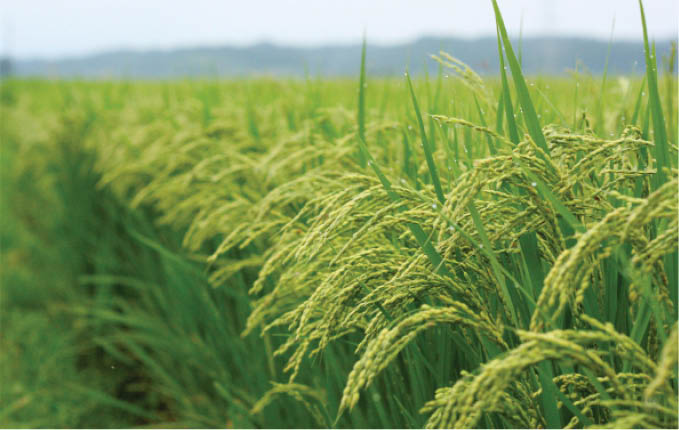AGRO SOLUTIONS: An electrifying way to make rice farming greener
Rice farming is a big-ticket item in greenhouse gas emissions. A staple food for more than half of the world’s population, rice is almost always grown in flooded paddies, contributing 11 percent of all human-related methane to the atmosphere. This amounts to nearly 40 million tons of methane annually. The source of that methane is […]

File photo: A rice farm
Rice farming is a big-ticket item in greenhouse gas emissions. A staple food for more than half of the world’s population, rice is almost always grown in flooded paddies, contributing 11 percent of all human-related methane to the atmosphere. This amounts to nearly 40 million tons of methane annually.
The source of that methane is produced by bacteria that thrive in paddies, but scientists have discovered a strange electrical life form that could significantly reduce current environmental impacts. This life form, known as cable bacteria, was first identified in the ocean and recently has been found to grow naturally in fields among rice roots in Asia and the US. Scientists are next figuring out what conditions favour cable bacteria, which could be a game-changer for reducing emissions.
Cable bacteria, which conduct electricity, curb methane production in the soil. In 2020, researchers discovered that cable bacteria reduced methane emissions by 93 percent in laboratory soil where rice was grown. The cable bacteria upset the balance of power in the community of soil microbes and methane-producing bacteria were the overwhelming losers.
Methane production is inefficient for bacteria; if there’s an alternative, they will seize it.
“Methane production is the last resort of the microbial community. When [microbes] can do nothing else, they make methane,” says microbiologist Derek Lovley of UMass Amherst.
Cable bacteria are long and thin, their bodies only one cell wide. When viewed under a microscope, they glow like ghostly hair flowing from rice roots. The way they control methane is by changing the soil chemistry. Cable bacteria increase beneficial sulfates in the soil and keep that level stable—no sulfate supplementation needed. They don’t directly harm methane producers, but they create conditions that crowd them out.
Microbes are highly competitive with one another, and when one type blooms, others often die out. If the grass on your lawn is healthy, it’s harder for weeds to take hold than it would be in bare soil– the same is true with microbes. That’s why some people take probiotic supplements to keep their guts healthy. Similarly, when cable bacteria thrive in soil, they feed the bacteria that consume sulfates, shutting out competitors that would otherwise produce methane.
As a side benefit, cable bacteria are rice-friendly because they remove sulfides from the soil. Vincent Scholz is an electro microbiologist at Aarhus University in Denmark who participated in both studies mentioned above. While sulfate is a plant nutrient, Scholz says, sulfide is a plant toxin and depresses grain yields. And it’s a two-way street: rice plants also help cable bacteria by passing dissolved oxygen to cable bacteria through their root structures.
But knowing how cable bacteria work their magic is just part of the solution. What conditions make a rice paddy cable-ready?
Researchers are investigating conditions that favor cable bacteria. For example, do cable bacteria do better when rice fields are continuously flooded—standard practice in the US—or when rice fields are intermittently drained and flooded? How much oxygen do they need?
The question of intermittent paddy flooding has been on the table for several years, not just because of cable bacteria. Alternate wetting and drying reduced methane emissions by up to 90 percent in one 2018 study. A 2020 study found that alternate wetting and drying reduced net greenhouse gases, not just methane, by about 22 percent. If this benefit could be combined with a healthy population of cable bacteria, it would make rice far more climate-friendly.
Scholz says water management is crucial. Cable bacteria are finicky about oxygen exposure. They are stressed if left in the open air but need some oxygen to survive. The trick is finding a happy medium that favours cable bacteria and robust rice yields. Further looking into water management is likely the next avenue for agricultural research on cable bacteria.
A new study from China demonstrates that cable bacteria thrive when more oxygen is available in the water. Cable bacteria in oxygen-rich water were more robust, reproduced faster and grew deeper into the soil. Field studies could build on this promising result to test adding oxygen to the water in rice paddies. Water can be oxygenated in low-tech ways, so the method need not be expensive. Alternative wetting and drying may also boost oxygen levels in soil.
Once scientists work out the ideal water and oxygen conditions, there should be few technical challenges to using cable bacteria to reduce methane emissions in rice farming. Farmers whose paddies contained native cable bacteria could create conditions that help these beneficial bacteria grow. Farmers without cable bacteria could seed them into the soil during field preparation.
Scholz, who has grown cable bacteria in Germany and Denmark, says they are “very easy” to grow. His colleague, Lars Peter Nielsen, who discovered cable bacteria, adds that you can grow “a kilometer of cable bacteria in a cubic centimeter, and that’s a lot.”
Nielsen cautions against getting ahead of the research, however. There is still much to learn about cable bacteria. And, Nielsen says, “we’re still getting shocked.”
Source: Modern Farmer
